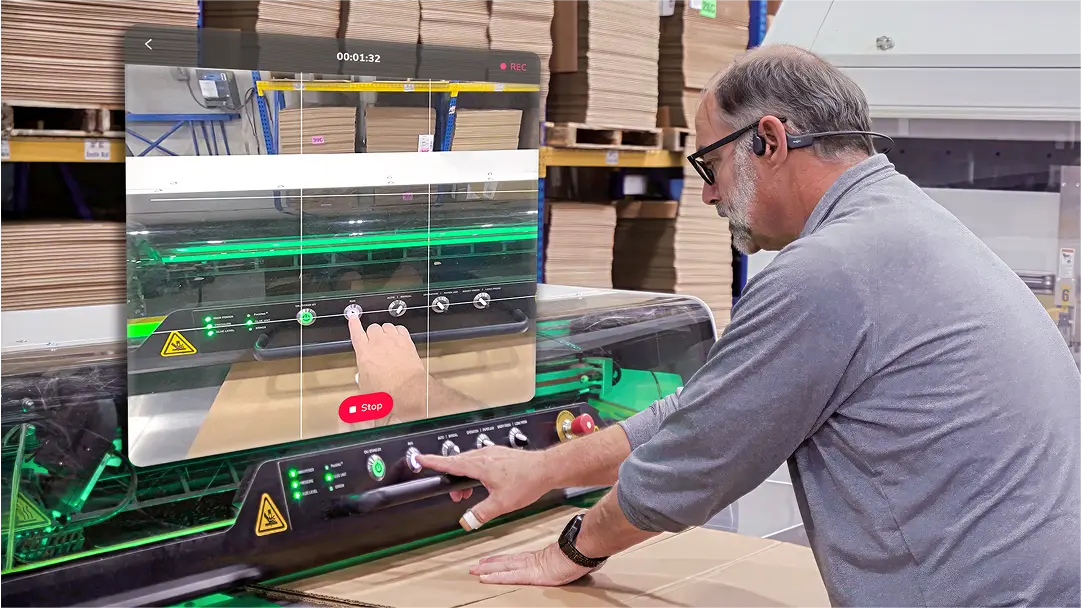Key takeaways
- Point of view matters: 1P videos drive faster, more accurate performance than 3P.
- Reduce cognitive load: 1P aligns with how the brain encodes actions.
- Easy, impactful change: Simple 1P capture boosts speed, accuracy, and operator confidence.
Why point of view matters
In operations, clear and easy-to-follow procedures are mission critical. Yet beyond documentation, the way instructions are delivered has a profound impact on performance. Research across cognitive science, neuroscience, and human-computer interaction (HCI) strongly indicates that step-by-step guidance filmed from the worker’s own perspective (first-person or 1P) leads to markedly better outcomes than when filmed from a third-person point of view (3P). Studies show tasks are completed faster and more accurately when users watch a 1P video as compared to the same task filmed in 3P. This perspective principle suggests that performance improves when video instructions or walkthroughs are viewed through the operator’s eyes [1].
The science behind first-person capture
The added boost from a 1P point of view reflects how our brains are wired. Watching a task unfold from your own viewpoint engages embodied cognition, as your brain effectively simulates performing the task itself. Neuroimaging studies with functional MRI (fMRI) show that observing actions from a 1P perspective activates motor and parietal regions more strongly than viewing them from a 3P perspective [2]. Research has shown that users benefit from increased activity in the mirror-neuron system (MNS) during procedural videos when the model’s hands are shown, as if through the user’s own eyes, rather than a third-person view. This leads to imitating actions more quickly and with fewer errors [3].
Cognitive science shows additional benefits for procedural comprehension when using first-person rather than third-person videos; cognitive load is reduced. When users watch a third-person video, their brain has to transform that view into their own perspective—a mental rotation or reorientation that requires extra processing. These visuospatial transformations impose extraneous cognitive load, which can actually impair performance. In contrast, first-person videos show exactly what the user will see and do, eliminating the need for mental translation [1]. Eliminating that effort means that the 1P perspective frees up working memory, allowing users to focus fully on the task itself.
Results from research and real-world testing
Multiple studies have confirmed the performance benefits of watching procedures from a first-person perspective. In operations ranging from circuit assembly to knot-tying, users who consume 1P videos consistently outperform those consuming 3P videos. In a controlled study focused on building electronic circuits, those who watched a first-person video could assemble circuits significantly more accurately and faster than those who saw a third-person view [1]. Imitation studies have also shown that arm movements are more accurately imitated from a first-person cue rather than from a third-person cue [4]. Taken together, these results further show that procedures captured from a first-person point of view can accelerate speed and reduce mistakes for frontline workers.
The practical takeaway: capture the expert’s point of view whenever possible. A first-person video places the operator inside the instruction, mimicking how mirror neurons and motor systems naturally encode the task. This embodied perspective has been shown to improve execution.
Tools and techniques for capturing 1P content
Filming procedures in 1P is now easier than ever. Some common approaches include the following:
- Smartphones: Most people already have a smartphone that’s capable of filming HD video. Body or head-mounted is even better (closer to eye level); by strapping it to a head, chest, or helmet, SMEs can record exactly what they see.
- Pros: Inexpensive, ubiquitous; high-quality camera; easy to upload video
- Cons: Not designed to be worn hands-free, so finding the right mount is extra effort; battery life may be limited; audio pickup can be limited; field of view is not the widest.
- Action cameras: Purpose-built action cameras like GoPro or Insta360 are small, rugged, and built for first-person filming.
- Pros: Easy to mount on the body; typically a wide-angle lens to capture everything; image stabilization; durable for workplace settings; relatively low cost
- Cons: Too wide a lens can distort perspective; built-in microphones may not capture voice-over in noisy environments
- AR glasses/headsets: Devices like Vuzix or Ray-Ban smart glasses or RealWear headsets put a camera right in the operator’s line of sight.
- Pros: Fully hands-free operation; line of sight POV
- Cons: More expensive; bulk and battery life may limit longer-term usage; requires more complex setup
- Immersive headsets: Immersive devices like Apple Vision Pro or Meta Quest can record and stream first-person views with extremely high fidelity. 4K cameras provide pass-through features so users can see their real hands and environments even while wearing the headset..
- Pros: Cutting-edge visual quality and interface; additional applications outside of recording and viewing video
- Cons: Highest cost option; devices are relatively new and niche compared to other options; headsets may have restrictions in a warehouse or manufacturing setting
It doesn’t take extremely specialized equipment to leverage 1P videos. Even a smartphone on a chest harness can significantly boost procedure comprehension as compared to a static third-person camera. The goal is to let operators see exactly what they would see if they were doing the job themselves.
The takeaway: capture through the operator’s eyes
Capturing procedural content from a first-person point of view leverages how our brains encode actions. Research across neuroscience and cognitive learning studies consistently shows that point of view matters. For operations managers, a simple shift in capture perspective can deliver measurable results—fewer errors, faster task completion, and more confident, capable operators.
References
[1] Fiorella, L., van Gog, T., Hoogerheide, V., et al. (2017). It’s all a matter of perspective: Viewing first-person video modeling examples promotes learning of an assembly task. Journal of Educational Psychology, 109(5), 653–665.
[2] Lorey, B., Bischoff, M., Pilgramm, S., Stark, R., Munzert, J., & Zentgraf, K. (2009). The embodied nature of motor imagery: The influence of posture and perspective. Experimental Brain Research, 194(2), 233–243.
[3] Watanabe, R., & Higuchi, T. (2016). Behavioral advantages of the first-person perspective model for imitation. Frontiers in Psychology, 7, 701.
[4] Barhorst-Cates, E. M., Isaacs, M. W., Buxbaum, L. J., & Wong, A. L. (2022). Does spatial perspective in virtual reality affect imitation accuracy in stroke patients? Frontiers in Virtual Reality, 3, 934642.


.webp)






-min.jpg)



